The Army faced two different threats in the Vietnam War, preventing it from focusing on exceptional performance in either conventional or unconventional warfare. The conventional forces of the North Vietnamese Army demanded respect from the U.S. Army. At the same time, the unconventional insurgency of the National Liberation Front of South Vietnam (known as the Viet Cong) presented a very real threat to Soldiers throughout the conflict. Tunnels were particularly useful in the insurgency and a series of tunnel networks provided the Viet Cong with manufacturing, resupply, and planning space within easy striking distance of their targets. Few Soldiers could fit into the tunnels and follow the guerillas into their lairs. While ordinary Soldiers occasionally went into the tunnels the Army recognized the need for a select group of experts to solve this unique problem. Aside from helicopter pilots and Long Range Reconnaissance Patrols, few conventional (non-special operations) Soldiers would place themselves so consistently in danger in Vietnam. These Soldiers were the “tunnel rats”: volunteer specialists who ventured into the labyrinth knowing that every step in the dark could be their last.
An Unconventional Mission
The Army’s search and destroy missions in 1966 began uncovering a large network of tunnels near Saigon. III Corps estimated one such tunnel network had been made over the course of up to 20 years and had small, well-camouflaged entrances. Viet Cong tunnels were generally either simple, shallow structures used as refuges and fighting positions or large, complex networks used to evade detection of medical, staging, or command areas. The layers of clay used to construct the walls and ceiling defied easy demolition or collapse of the tunnel. Some tunnel networks stretched thousands of feet and contained several levels and chambers. Underneath the ground an entire army could plan, train, and move without disturbance even when, as was the case in Cu Chi, the U.S. built a major base on top of a massive tunnel system.
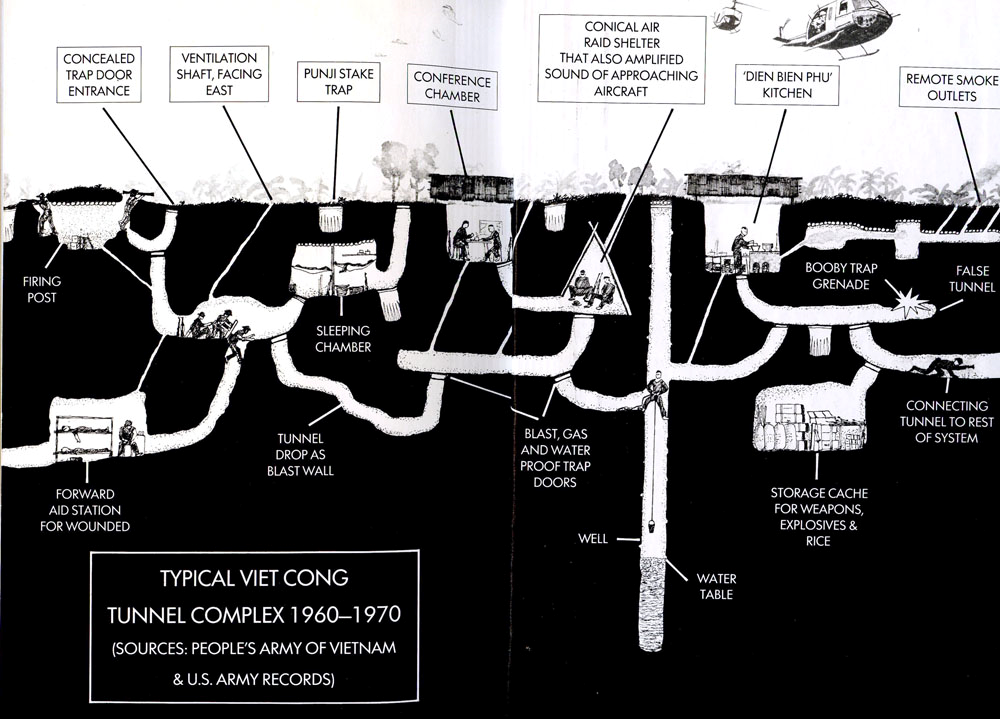
A diagram of a basic Viet Cong tunnel system. U.S. Army
When found, tunnels often contained valuable intelligence or supplies. But the tunnels presented two difficulties for the Army: they were small, often too small for most Soldiers to fit in, and they were wholly unknown. The tiny tunnels, most only measuring two feet by three feet, meant Soldiers could only enter one at a time. No two tunnel complexes were ever the same layout, with sections joining at various angles in a zigzag pattern.
The Tunnel Rat and His Gear
The Army initially had trouble figuring out how to deal with the tunnels. Bombing was ineffective: even 750-pound bombs landing 50 yards away from a tunnel entrance had no effect on either the tunnel or the entrance. Attempts to “smoke out” Viet Cong with tear gas or smoke grenades failed in the larger networks. Dogs sent down could not avoid any booby traps. The average Soldier sent down to explore an entrance usually failed to recognize the connection of surface tunnels to deeper networks. While hasty clearance often fell to the smallest Soldier in an infantry squad or platoon, asking them to go into deeper tunnels was generally counter-productive. Many casualties among these untrained Soldiers came from accidents in the tunnels instead of enemy action. Capt. Herbert Thornton, a chemical corps officer with the 1st Infantry Division responsible for contaminating the tunnels with chemical agents, created specialized teams to enter, clear, and exploit the tunnels in 1966. Deliberate tunnel clearance fell to this group of volunteer infantryman, engineers, and chemical weapons experts.
The tunnel rats were an eclectic group selected for unique characteristics. Most were short (most less than 5 feet 5 inches) with a slight, wiry build. The job also required a special kind of mental toughness: crawling for hours in claustrophobic darkness expecting mortal danger could break down even the bravest men. The job also demanded lightning-quick reflexes and no hesitation: confrontations with venomous snakes or Viet Cong often occurred at hand-to-hand range. Thornton knew a tunnel rat “had to have an inquisitive mind, a lot of guts, and a lot of real moxie in knowing what to touch and what not to touch to stay alive—because you could blow yourself out of there in a heartbeat.” Many tunnel rats avoided the vices common to their fellow Soldiers: drinking, smoking, candy, and chewing gum could dull their sense of smell and give away their position. Instead, they trained themselves and others to survive underground.
Some Soldiers took to the work with gusto: Staff Sgt. Pedro Rejo-Ruiz, a wiry Cuban immigrant who became known as “the human probe,” and Sgt. Robert “Batman” Batten volunteered to serve two extra tours with the tunnel rats. Batten joined Cpt. Thornton on the Viet Cong’s top ten most wanted list (only below top generals) because of how effective Batten and Thornton’s tunnel rats became. Rejo-Ruiz had been fighting his entire life; as a teenager in the early days of Fidel Castro’s Cuba he routinely harassed the communist troops with gunfire. After his family fled to the United States, he joined the Army to continue to fight against what he saw as an encroaching threat. Rejo-Ruiz had been defying death as a mine detector in the 1st Infantry Division before offering his services to the tunnel rats. He became obsessed with the challenges and theory of tunnel warfare and went down tunnels known to have guerillas hiding in them, particularly when another tunnel rat had been wounded while clearing. After becoming a naturalized citizen while recovering from injuries sustained in combat, he immediately returned to the tunnels and was one of the few rats to survive the deadly game of cat and mouse.
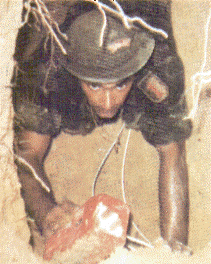
Staff Sgt. Pedro Rejo-Ruiz in his element. U.S. Army
Soldiers in tunnels had to travel light and abandon their technological advantages. Helmets, load bearing equipment, and even water canteens might be too bulky to carry underground. Some tunnel rats even abandoned their uniform coat. Soldiers began entering with a pistol and flashlight, and the Army later added a communications wire, compass, and bayonet to help them check for traps and communicate to the surface. Tunnel rats often carried a gas mask to protect against poison gas traps, but many decided to leave even that above-ground. As the war went on and tunnel rats refined their techniques, most ended up taking less and less down into the tunnels.
Denying Refuge
Often, gaining entry to the tunnels was difficult as the doors were challenging to discover without careful search. The tunnels generally lacked electric lighting and cleverly hid ventilation to minimize traces. Most tunnels required painstaking exploration to uncover and tunnel rats arrived on scene only after regular patrols had uncovered an entrance. Other times it was easy. In one instance, a Soldier and his German Shepherd were in the lead of a patrol when the dog suddenly stopped and sat. The patrol immediately stopped on alert: the dog had been trained to sniff out the enemy. Suddenly, the top of a well-hidden tunnel flew open and a Viet Cong soldier jumped out holding grenades. He was immediately shot and killed. A tunnel rat went down in the tunnel and captured a high-ranking Viet Cong officer.
Finding an entrance did not guarantee entry: Viet Cong often booby trapped the doors or placed grenades in nearby trees to kill Soldiers trying to gain entry to the tunnel systems. Once Soldiers gained access to a tunnel system, tunnel rats had a difficult decision to make about their gas mask. The gas mask deadened sounds by making a Soldier’s breathing seem louder and restricted his sight. But most tunnel rats could not pull out and don their gas mask inside the tunnel should they encounter poison gas released by fleeing Viet Cong. By 1969, experienced tunnel rats would first roll a fragmentation grenade into the entrance or blow the entrance open with explosives. The latter option also tended to solve the problem of booby-trapped doors and both meant that the rat could at least enter the tunnel unopposed, which some rats preferred despite alerting anyone below to their presence.
Once in the tunnel network, the real dangers began. Tunnels were dug to dissipate shock waves from explosions. This construction also obstructed Soldiers’ lines of sight: an ambush by the Viet Cong could be waiting around every bend. The tunnel system could be home to venomous snakes (whether living there or kept as traps by Viet Cong) or scorpions around every corner or in any wall indentation or hidden ledge. Spiders, mosquitoes, and bats annoyed and distracted Soldiers already on edge. Nature’s obstacles are enough for modern cavers to deal with but they were the tip of the iceberg for tunnel rats.
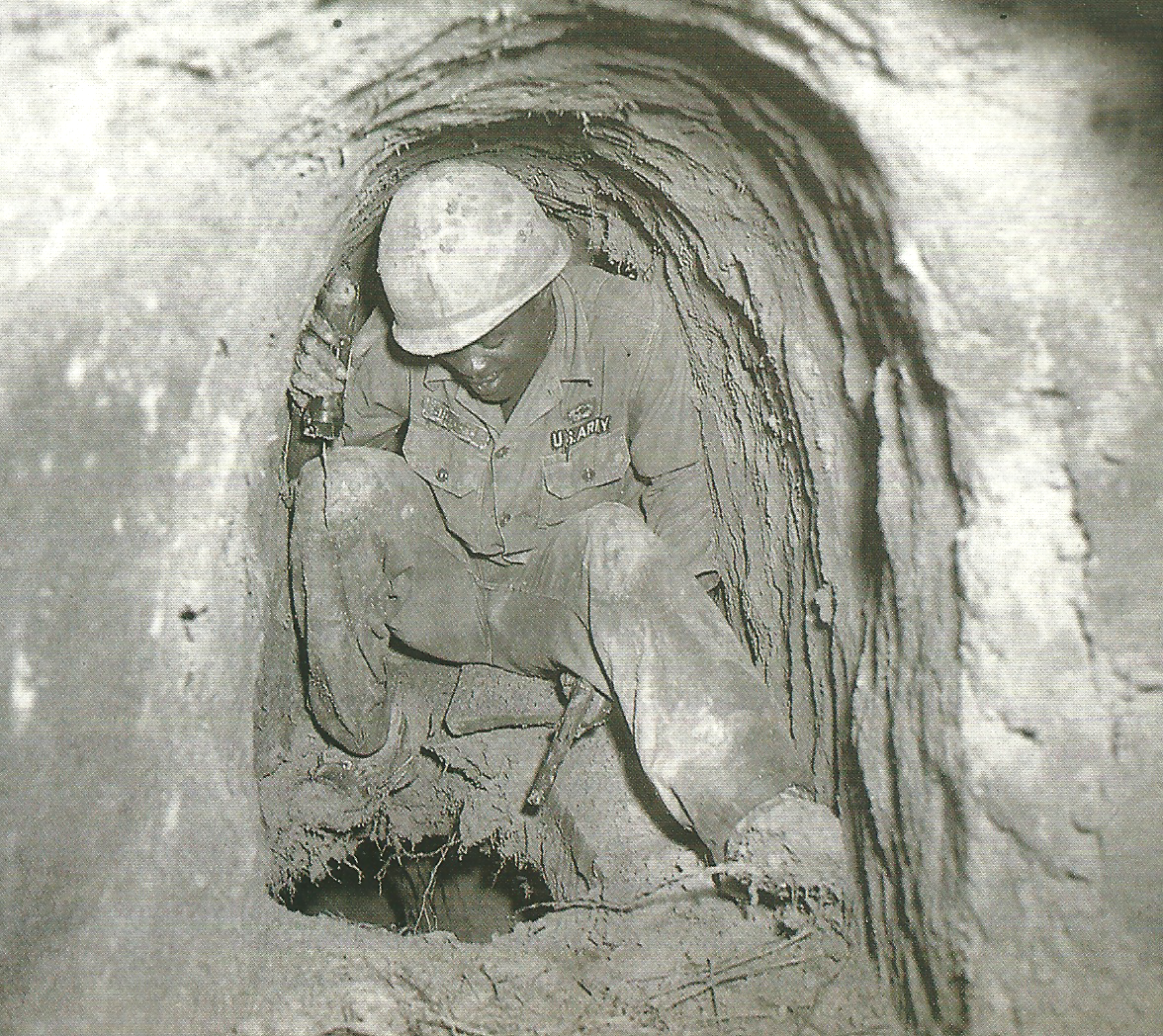
A tunnel rat explores a hole between “floors” of the tunnel system. These changes in elevation were among the most dangerous situations for tunnel rats because they could not ensure no traps or enemy were present before going through. U.S. Army
The Viet Cong built booby traps in most of the tunnel systems. Tunnel rats could expect grenades, poison gas, punji stake traps, and tethered venomous snakes. None of these traps would have the audio or scent signature a tunnel rat could recognize from a guerilla waiting in ambush. As Harold Roper, a tunnel rat in the early days of 1966, recalled: “I felt more fear that I’ve ever come close to feeling before or since.” There were only around 100 Army tunnel rats in Vietnam and most either died in the tunnels or in ambushes on the surface. This built a special culture among the tunnel rats, who ensured that no rat, wounded (and most were at least once) or dead, was ever left inside a tunnel. The tunnel rats went above and beyond to avenge their injured or fallen comrades: Rejo-Ruiz crawled through choking tear gas into a tunnel with a cratering charge to finish the job after the Viet Cong had wounded two other rats. Another time, the rats used 300 pounds of C-4 to blow the top off of a tunnel system when one of their number had been injured.
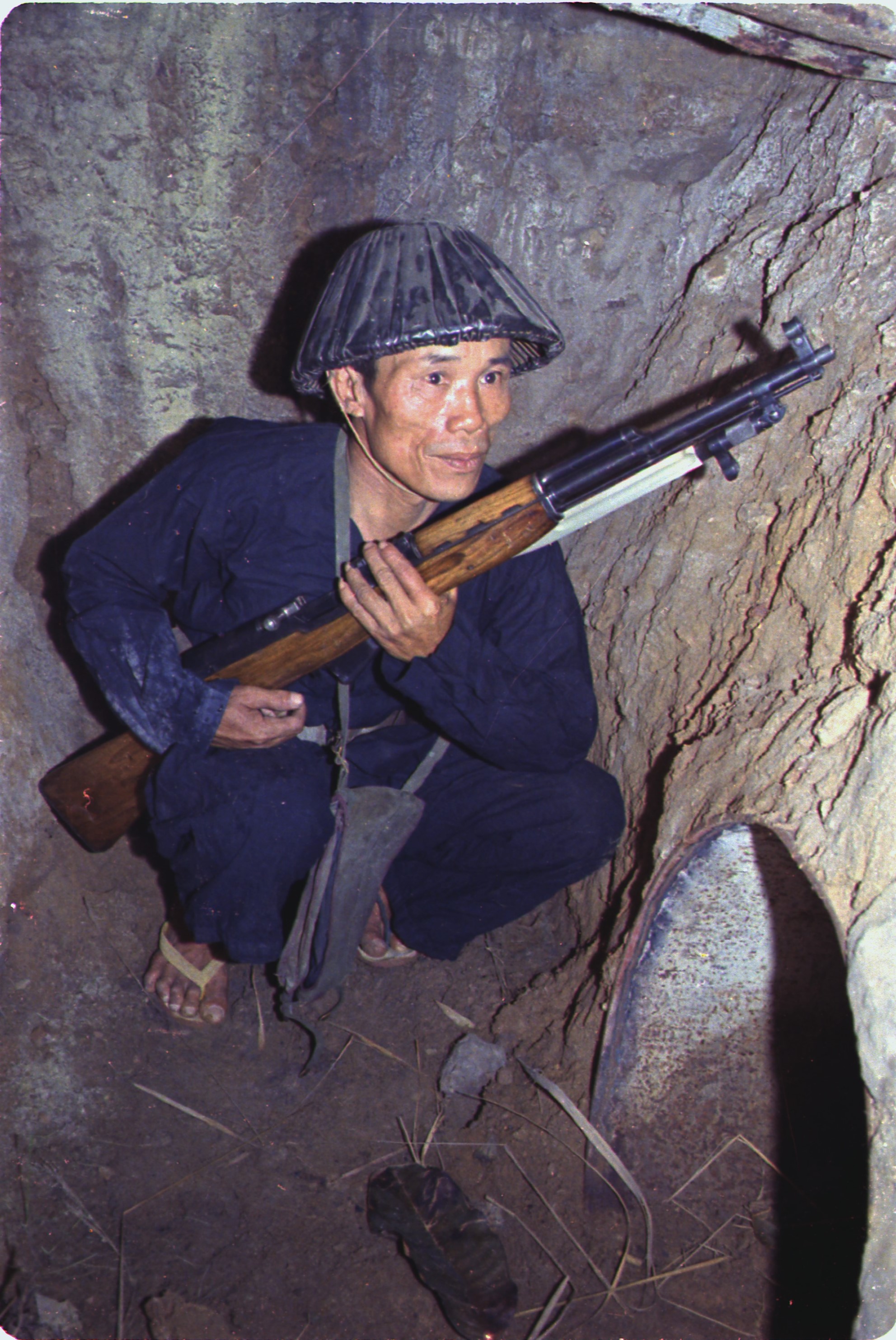
A Viet Cong soldier crouches in a bunker with an SKS rifle. A connecting tunnel is in the foreground. National Archives and Records Administration
Tunnel Tactics: Innovation on the Job
Tunnel rats moved from ad hoc discovery of best practices to writing a new set of tactics, techniques, and procedures for clearing tunnels. While only one tunnel rat could fit abreast in the tunnel, occasionally a second rat would enter behind to provide assistance to the lead rat (particularly when the lead rat was new). The rest of his unit provided security and at least one other Soldier remained at the entrance at all times. Many tunnel rats maintained communication with their partner, who recorded the tunnel rat’s actions and attempted to sketch out the tunnel and any significant findings. When contact with Viet Cong soldiers was expected, many tunnel rats preferred to have nothing distracting them from the deadly game of hide and seek. Soldiers learned to never fire more than three shots before reloading in order to keep Viet Cong from rushing them while they reloaded. Underground the rats eventually switched to using red-lensed flashlights, since the Viet Cong only used white lights and candles. Upon leaving the tunnels they whistled an agreed-upon tune so their muddy figure would not be mistaken for a Viet Cong guerilla.
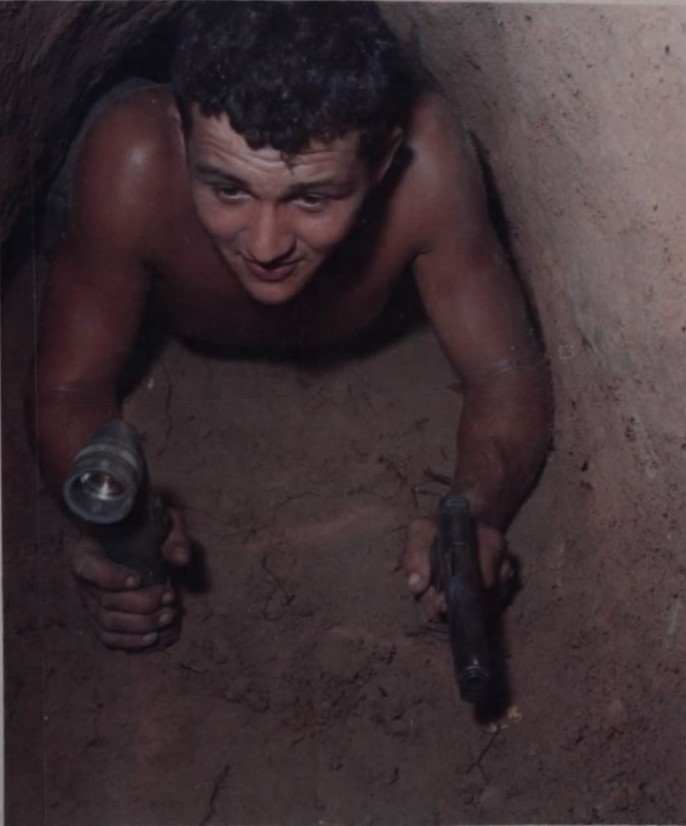
Sgt. Ronald Payne of the 25th Infantry Division, moves through a tunnel in Operation “Cedar Falls,” January 24, 1967. Note the M1911 pistol and lack of red lens over the flashlight, both choices which would fall out of favor as the tunnel rats honed their craft. National Archives and Records Administration
While early tunnel rats entered the tunnels with a M1911 .45-caliber pistol, most found the standard sidearm unfit for the task. The .45-caliber round was too loud and the muzzle flash too bright. If he needed to fire, using a 1911 denied a tunnel rat of two crucial senses for critical seconds. Some used silencers, some did not; some carried shotguns and other revolvers. Soldiers learned what worked best in their area and with their techniques and stuck with them. Viet Cong in the tunnels rarely surrendered, so few tunnel rats wanted to experiment. The knife or bayonet was a perennial favorite: this simple blade was a bayonet probe, booby trap disarmer, snake dispatcher, and weapon in one hand that never jammed or malfunctioned.
Once the tunnel rats had retrieved any information, equipment, or prisoners they could find, they set out to destroy the tunnel or deny its use to the Viet Cong in the future. The hard-packed, layered clay of the tunnels made such an operation very difficult. Early on, Soldiers tried destroying the tunnels with conventional explosives, with mixed results. Collapsing tunnel entrances by igniting a mix of acetylene gas and oxygen with small charges worked well for more shallow tunnels. This method was too slow, inefficient, and cumbersome to use unless the area was completely secure. To deny tunnels the rats filled deeper tunnels with riot control agents like a powdered form of tear gas while collapsing the entrances with explosives. Denial generally made the tunnels unlivable for between two to six months. These deliberate operations all took time, a commodity most commanders lacked, so the tunnel rats’ search was often the most impactful part of an anti-tunnel operation. Once done with their mission, the rats either returned to base or took a helicopter to the next tunnel in their area of operations.
Impact and Legacy
In the amorphous world of the Vietnam War the exact impact of the tunnel rats was sometimes difficult to determine but the rats found and exploited things no one else did. According to a former Viet Cong officer, the tunnel rats eliminated over 12,000 guerillas and captured many more. In a single operation in August 1968, the rats not only killed 3 Viet Cong but captured 153 more. Most captured Viet Cong weapons and equipment were uncovered by the tunnel rats. During one operation the tunnel rats found 6,000 pounds of rice and 40 pounds of salt in a 120-foot-long tunnel. Another underground complex covered 2,000 meters and yielded cameras, films, printing presses, and type, in addition to the usual cache of weapons and ammunition. One tunnel rat stumbled across a missing M-48 tank the Viet Cong were using as a command center and others routinely uncovered hidden artillery pieces and mortars. In 1970 tunnel rats uncovered a major signals intelligence node underground. Viet Cong codebreakers had been intercepting, decoding, and translating every transmission from the 1st and 25th Infantry Divisions; the sudden loss of information immediately made both divisions more effective and safer from deliberate ambushes. In addition to lists of spies passing information to the Viet Cong, the tunnel rats often uncovered maps, orders, and battle plans which helped save more American lives.
Soldiers sent down the tunnels disrupted the Viet Cong and found information their units could exploit. As the Army improved its ability to process and use the information the tunnel rats provided, the tunnels became more dangerous than useful for a Viet Cong decimated by the Tet Offensive and U.S. counteroffensive. The tunnel rats chose to go down into unfamiliar territory, without the benefits of modern technology, to deny the Viet Cong any sanctuary. In a complicated war with a painful history in American culture, the courage, skill, and nerve of the tunnel rats shone as they invented a military skill in the midst of mortal danger.
Jonathan Curran
Graduate Historic Research Intern
Sources
Department of Defense. Staff Film Report 66-25A. Original uploaded to the Internet Archive. https://archive.org/details/gov.dod.dimoc.26977.
Gorner, Peter. “Life of a Tunnel Rat: Fighting Fear in ‘Nam.” Chicago Tribune, June 28, 1985. https://www.chicagotribune.com/news/ct-xpm-1985-06-28-8502110841-story.html.
Lehrer, Glenn H. “Viet Cong Tunnels.” The Military Engineer 108, no. 703 (2016): 60–63.
Mangold, Tom, and John Penycate. The Tunnels of Cu Chi. New York: Berkley Books, 1986.
Page, Tim and John Pimlott, ed. Nam: The Vietnam Experience 1965-75. Hong Kong: Orbis Publishing, Ltd., 1988.
Ploger, Robert R. Vietnam Studies: U.S. Army Engineer, 1965-1970. Washington, D.C.: U.S. Government Printing Office, 1974.
Sam Johnson Vietnam Archive Collection, Vietnam Center and Sam Johnson Vietnam Archive. Texas Tech University, Lubbock, Texas.
Traas, Adrian G. Engineers at War. Washington, D.C.: Center of Military History, 2010
